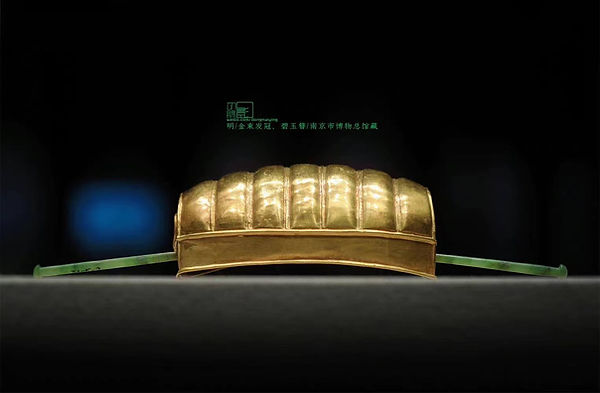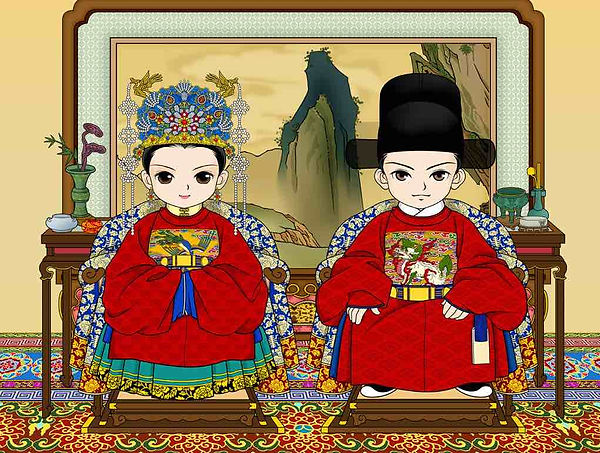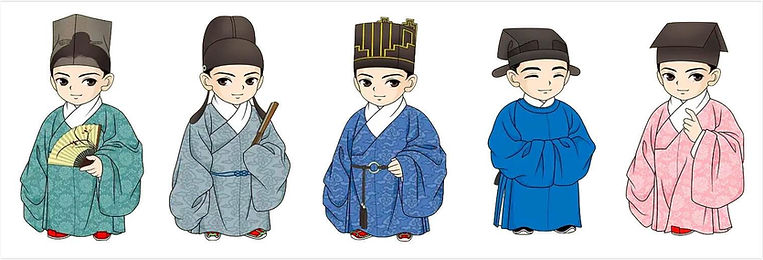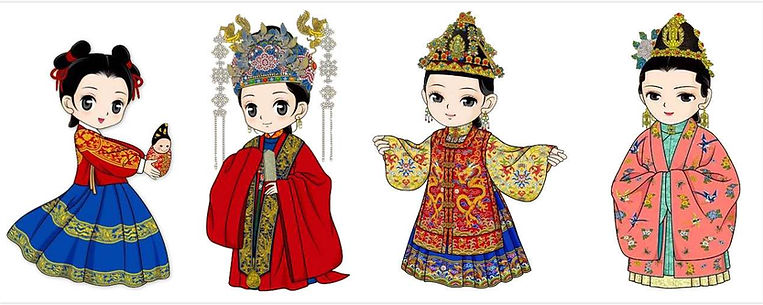Coming of Age in Chinese Culture — Meaning, Traditions, and Ceremonies
Coming of Age signified the qualification for marriage, participation in social activities, and the assumption of adult responsibilities, including paying taxes and serving in the military.
For heirs of thrones, it meant obtaining the credentials for absolute power and the ability to reign over a country.
Hence, in the long history of China, celebrating the Coming of Age Ceremony has always been one of the most momentous occasions in one's life.

Gold and Jade Hat or Guan of the Ming Dynasty (1368 — 1644), for Men to Wear After Coming of Age Ceremony — Nanjing Museum (Photo by Dongmaiying)
General Procedure of the Coming of Age Ceremony in Ancient China
Coming of Age Ceremony for Men — Guan Li
Coming of Age Ceremony for Women — Ji Li
The Rise and Decline of the Coming of Age Ceremony in History

Gold Hairpin or Zan Decorated with Gems of the Ming Dynasty (1368 — 1644), for Women to Wear After Coming of Age Ceremony — Qichun Museum (Photo by Dongmaiying)
Definition and Traditions of the Coming of Age Ceremony
In ancient China, the Coming of Age Ceremony was the ritual that declares one is accepted by the clan and society as an adult, will start taking relevant responsibilities, and is qualified to inherit power and titles.
It was started among nobles in the Zhou Dynasty (1046 BC — 256 BC) and later spread to civilians.
The most common age to hold the ceremony was 20 for men and 15 for women in ancient China. But throughout history, between 10 and 20 are all acceptable.
At the ceremony, respected elders would put special caps or Guan on a man's head, tie up a woman's hair using hair ornaments named Ji or Zan, and dress up with relevant robes or accessories.
Afterward, one would keep the new look as a grown-up.
In ancient Chinese culture, Hat (Guan) and Clothes (Fu) as a whole set represented one's social status, age, occupation, and educational background.

Whole Sets of Costume (Guan and Fu) of High Rank Official and His Wife of the Ming Dynasty (1368 — 1644) — By Xiefang Zhuren (Dong Jin)
General Procedure of Coming of Age Ceremony in History
Choosing the Date and Preparations
In old times, the year of holding the ceremony was usually connected to one’s momentous occasions, such as before marriage, before inheriting a title or the throne, or just common regulation of 20 for men and 15 for women.
The date, however, was usually set after careful divination.
The holding place and the host usually would be the most honorable ones that a family could get.
The Day of the Coming of Age Ceremony
The parents would give a short speech at the ceremony after all the guests had sat in the correct position.
Then the person who was about to be an adult would bow and show gratitude to all the guests for attending.
A respected elder chosen to hold this ceremony would wash their hands. In several steps (different throughout history and hierarchy), Guan Li for Men and Ji Li For Women to tie their hair up and help them to change the costume to an adult.
After each step, the coming adult would kowtow to parents, respectable elders, and teachers, as a means to show gratitude for giving birth to, raising, taking care of, and educating them.
Sometimes they would kowtow to show their loyalty to their country and willingness to inherit Chinese culture.

Receiving a Courtesy Name
Then the coming adult would get a Courtesy Name or honorific name.
Afterward, other people would call one's courtesy name to show respect; only one's elder relatives could call the real name.
Final Rites of the Ceremony
In the end, they would pour some wine on the ground to worship heaven and earth, drink a sip and eat one bite of rice, symbolizing the beginning of experiencing everything in life, both ups and downs.
Then, they would kneel on the ground and listen to their parents' teaching or expectation.
After showing gratitude to guests again, they could finally stand next to their parents as adults.

Common Hairstyle and Costumes of A Civilian Couple of the Ming Dynasty (1368 — 1644) — By Xiefang Zhuren (Dong Jin)
Coming of Age Ceremony for Men — Guan Li
In Chinese history, Clothing was an essential means to show one’s social status, occupation, and age.
Hence, the ceremony also followed strict hierarchy regulations.

Hair and Costume of Child (Prince) of the Ming Dynasty (1368 — 1644) — By Xiefang Zhuren (Dong Jin)
The hierarchy could be shown in the steps of the coming of age ceremony for men:
-
First, put on a fabric-made hat that covers one’s hair, meaning he acquired the basic skills to take care of a family or manage people.

Different Types of Civilians' Fabric Hats (Guan) of the Ming Dynasty (1368 — 1644) — By Xiefang Zhuren (Dong Jin)
-
Second, put on a leather-made hat (Pi Bian Guan), centuries later changed to other types of hats that were symbols of power and military, which represented that a civilian was able to serve in the army or a king was able to take charge of military force.
Moreover, nobles would also wear a sword in this step.

Emperor's Hat and Costume (Pi Bian) of the Ming Dynasty (1368 — 1644) — By Xiefang Zhuren (Dong Jin)
-
Third, put on a more exquisite hat (such as silk made), which implied he was empowered to participate in grand worship ceremonies and to assist in governing the country through adequate knowledge and high morals.

Some Examples of Hats and Costumes of Different Ranks of Officials of the Ming Dynasty (1368 — 1644) — By Xiefang Zhuren (Dong Jin)
-
Fourth, royals, feudal lords, and high-rank officials would put on a costume that empowered them to hold sacrificial ceremonies to worship mountains, rivers, forests, and the earth of certain places.
-
Fifth, only the emperor, crown prince, or king would put on the costume named Gun Mian, a whole set that sovereigns wore on the most important occasions, like enthronement, worship of heaven and ancestors, etc.


Emperor's Most Honorable Ritual Robes (Gun Fu on the Left, Mian Fu on the Right) of the Ming Dynasty (1368 — 1644), Worn in Grand Events Like Worshiping of Heaven or Ancestors — By Xiefang Zhuren (Dong Jin)
Coming of Age Ceremony for Women — Ji Li
In ancient history, women didn’t have the same responsibility as men; their social roles mainly concerned being good daughters and sisters, good wives, and good mothers.
Therefore, the coming-of-age ceremony also contained three steps that presented a woman’s growth process.

Hairstyle and Costumes of Stages of A Princess' Life (Kid, Grownup, Married Lady, Mother) of the Ming Dynasty (1368 — 1644) — By Xiefang Zhuren (Dong Jin)
Women’s hairstyles followed the same rules based on their ages and marital status.
However, the decoration, patterns, and colors of their headdress and costumes still followed the strict hierarchy in history.


Different Hairstyle and Costumes of Married Civilian Women of the Ming Dynasty (1368 — 1644) — By Xiefang Zhuren (Dong Jin)
The Rise and Decline of the Coming of Age Ceremony in History
The Coming of Age Ceremony, one of the essential rituals in ancient Chinese culture, was set in the Zhou Dynasty (1046 BC — 256 BC) and was first popularized among nobles.
When the Qing Dynasty (1636 — 1912) ruled China, this ceremony was forced to end.
Nowadays, this ceremony has been recovered but is different in some specifics from what it used to be.
The Coming of Age Ceremony in China Today
Nowadays, boys and girls are considered adults when they are 18 in China.
Like other modern countries without a feudal hierarchy system, men and women in China go to school and work equally.
When people have more choices, whether they want to hold a ceremony or the place and style of the rituals, are mainly depend on themselves.
Some schools would hold a big ceremony for many students together; some parents may find event holders do this for their children.
Meanwhile, participants can wear traditional Chinese Han Clothes, school uniforms, or costumes of one's favorite dynasty in Chinese History.
Despite those diverse styles and details, the essence of the coming-of-age ceremony has never changed: opening up a new chapter as an adult and the awareness of one's responsibilities as a decent human being.
You Might Also Like:
Chinese Costume and the Strict Hierarchy in the History
Chinese Surnames — Eight Ancient Chinese Surnames and Their Evolvements
Chinese Names — Structure, History, Key Factors, Taboos, and Classic Examples
Chinese Zodiac Signs — A Comprehensive Introduction
Chinese Astrology — Three Enclosures, Four Symbols, Twenty-eight Lunar Mansions
Daily Etiquette in the Tradition of China
Hello in Chinese — Chinese Greetings in Daily Life and in Written Letters
Chinese Wine Culture and Table Manners









